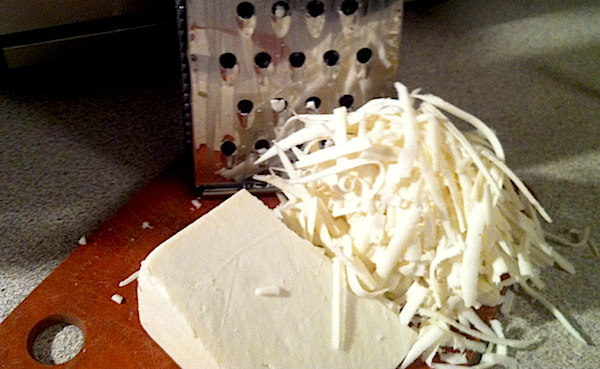 |
| Foto: Leonardo Ciampa (30 agosto 2014) |
| Ieri, ho scritto con estasi delle melanzane che ho acquistate dai mercati degli agricoltori qui in Natick. Sono tornato a casa, e ho preparato una Pasta alla Norma che è stata rapidamente consumata! Cinque o sei di questi splendidi piccoli melanzane sono rimasti. Cosa devo fare con loro? Ho preso una teglia da forno, l’ho ricoperta con carta stagnola, ho squartato le melanzane, le ho disposte sulla carta, e ho aggiunto evo, sale e pepe. Le ho cotte in forno a 220° C, fino a quando hanno cominciato a dorarsi. Basta. Questo è tutto ciò che ho fatto. Eppure il sapore era ricco oltre ogni descrizione. Un piccolo morso aveva più sapore di una grande melanzana intero dal supermercato. Parte II della storia: Avevo un contenitore di ricotta fresca, fatta dal Narragansett Creamery a Providence, Rhode Island (http://www.richeeses.com/). Quest’azienda produce formaggi artigianali freschi ogni giorno. La ricotta si chiama, “Renaissance Ricotta” (“Ricotta rinascimentale”). Secondo il sito web, il formaggio viene riscaldato in una pentola a vapore, poi a mano immerso in barattoli di stagno tradizionali. Gli ingredienti sono tre: latte, lattoinnesto, e sale marino. (Nessune sostanze chimiche.) Il sapore era di un altro mondo. Mia moglie (che una volta lavorava in un negozio di formaggi della Svizzera Romanda), l’ha assaggiato e ne ha avuto una reazione simile. Ho rimosso una melanzana arrostita dalla teglia, l’ho posta nel mio piatto, e con un cucchiaio ho messo la ricotta fresca sopra. È un’esplosione di sapore! Era così buona che ho mangiato solo quella, ho bevuto un mezzo bicchier di Pinot Grigio delle Dolomiti, bello e freddo, e quello è stato il mio pranzo intero. Eppure mi sentivo come se avessi mangiato cinque piatti. Poi, per cena, ho preso delle patate, comprate ieri dagli agricoltori. La stessa preparazione: su una teglia ricoperta, nel forno a 220° C. Ma così, semplici, senz’olio, senza nemmeno un granello di sale. Appena cotte ne ho prese una, l’ho dimezzata, e ho aggiunto burro. Punto e basta. Allora tenete a mente che a me piacevano poco le patate. Pensavo che fossero insapori e insipide. Ma queste patate! Tutto il sapore della terra donde sono venute! Una goccia dello stesso vino bianco, e basta. Non desideravo niente di più. Questo mi porta a una conclusione che ammetto con un po’ di dolore. Fino a un certo punto, le ricette sono inutili. Non esistono “ricette” per i pasti regali di oggi. È una questione non di PROCEDURA, ma di INGREDIENTI. Lo chef più bravo al mondo può seguire una ricetta prefettamente. Ma non può dare a un ingrediente del supermercato il gusto di un ingrediente della fattoria. | Yesterday, I wrote rapturously about the eggplants that I purchased from the farmers’ markets here in Natick. I returned home and made Pasta alla Norma, which was rapidly consumed! Five or six of these gorgeous little eggplants remained. What do I do with them? I took a baking tray, lined it with tin foil, quartered the eggplants, arranged them on the foil, and added EVOO, salt, and pepper. I baked them in the oven at 425° F, until they became golden brown. That’s it. That’s all that I did. Yet the flavor was rich beyond description. One small bite had more flavor than an entire large eggplant from the supermarket. Part II of the story: I had a container of fresh ricotta, made by the Narragansett Creamery in Providence, Rhode Island (http://www.richeeses.com/). This company makes artisan cheeses fresh, every day. The ricotta is called, "Renaissance Ricotta." According to the website, the cheese is heated in a steam kettle, then hand-dipped into traditional tins. There are only three ingredients: milk, starter, and sea salt. (No chemicals.) The flavor was of another world. My wife (who used to work at a cheese shop in the Suisse Romande) tasted it and had a similar reaction. I removed a roasted eggplant from the pan, placed it in my dish, and spooned the fresh ricotta on top. It was an explosion of flavor! It was so flavorful that I ate only that, drank half a glass of cold Pinot Grigio from the Dolomites, and that was my entire lunch. Yet I felt like I had eaten five courses. Then, for dinner, I took some potatoes, which I also bought yesterday from the farmers. The same preparation: on a lined baking sheet, in a 425° oven. But just like that, plain, without oil, without so much as a grain of salt. As soon as they were done I took one of them, cut it in half, and added butter. Nothing else. Now keep in mind that I didn't even really like potatoes. I thought they were bland and flavorless. But these potatoes! All of the flavor of the earth whence they came! A drop of the same white wine, and that was it. I didn't desire anything else. This brings me to a conclusion that is painful to admit. To a certain extent, recipes are useless. There are no "recipes" for today’s regal meals. It’s a question not of PROCEDURE, but of INGREDIENTS. The most skilled chef in the world can follow a recipe to a T. But he or she can’t make an ingredient from the supermarket taste like an ingredient from the farm. |































